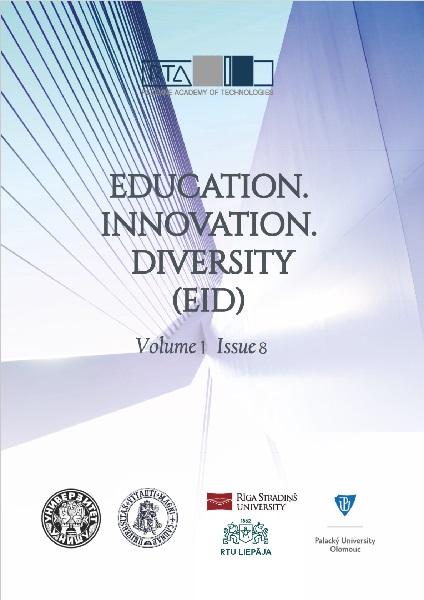VISUAL REMAINDERS AS A PEDAGOGICAL COMMUNICATION TOOL FOR TEACHERS, STUDENTS AND PARENTS
DOI:
https://doi.org/10.17770/eid2024.1.7939Keywords:
Basic school, education, pedagogical communication, visual remainderAbstract
When conversation takes place, especially when the conversation impacts one's whole life, it is crucial that all participants can speak ‘the same language’. Teachers should understand students and their parents, students should understand their parents and teachers, but parents should understand their children and also the teachers in order to reach a common goal, which is to provide the best possible education to the students. Therefore, it is important that when conversation is raised about a student's learning process, all participants maintain focus on the content of the conversation. The aim of this study is to explore how the application of visual remainders can improve communication between teachers, students, and parents. To reach this goal and determine if a visual remainder is a useful tool in pedagogical conversations, the scientific literature and normative documents were analysed, and a survey was conducted at a rural basic education school in Latvia. To analyse the obtained data, the Mann-Whitney correlation coefficients were calculated. This study proves that the participants emphasize different aspects of pedagogical conversations, therefore it is important to find a common solution on how to maintain the focus between all parties involved.
References
Barnard, G. A. (1955). Simple proofs of simple cases of the coding theorem. London: Butterworths.
Bela B., Ozola I., Rasnača L., Rezgale-Straidoma E., Roga-Vailza V., Romāne-Meiere A., & Rozenvalde I.. (2023). Sociālā darba vārdnīca. Rīga: Latvijas Universitātes Akadēmiskais apgāds.
Cabinet Regulation No. 747. Regulations Regarding the State Basic Education Standard and Model Basic Education Programmes (2018). Riga, Republic of Latvia.
Calaprice S. & Nuzzaci, A. (2018). The Importance of Listening to Children and Adolescents: Making Participation Integral to Education. Cambridge Scholars Publishing.
Chavkin, N. F. (1993). Families and Schools in a Pluralistic Society. Albany: State University of New York Press.
Cole, S. M. (2021). Contextualising parental involvement at the elementary level. International Journal of Early Years Education, 29(2) 139–153. DOI: https://doi.org/10.1080/09669760.2020.1777844
E-klase. (2024). E-klase. Retrieved from https://www.e-klase.lv/par-e-klasi/personas-dati
Gruman A. J., Schneider F., W, & Coutts L., M. (2017). Applied social psychology : understanding and addressing social and practical problems. Los Angeles: SAGE.
Kalvāns, Ē. (2018). Attīstības psiholoģija. Rēzekne: Rēzeknes Tehnoloģiju akadēmija.
Kesavelu D., Anandapandian P. A. & Kumari S. (2021). Stages of Psychological Development of Child-An Overview. International Journal of Current Research and Review. 13(13) 74-78. DOI: http://dx.doi.org/10.31782/IJCRR.2021.131320
Mapp, K. L. (2003). Having their say: Parents describe why and how they are engaged in their children’s learning. School Community Journal, 13(1), 35–64. Retrieved from http://www.adi.org/journal/ss03/Mapp%2035- 64.pdf
Mehrabian, A. (1972). Nonverbal Communication. New York: Transaction Publishers.
Pāvulēna L., Pāvulēns J. (2023). Conversations between Rural Basic School Students, Parents and Teachers about Students’ Learning. Rural environment. Education. Personality. 16, 112-120. DOI: https://doi.org/10.22616/REEP.2023.16.013
Pushor, D. (2023). Education [and Schooling] in a Pivotal Time. LEARNing Landscapes, 16(1):21-25.
Quigley A., Muijs D. & Stringer E. (2019). Metacognition and self-regulated learning - Guidance Report. London: Education Endowment Foundation.
Rogoff, B. (2003). The Cultural Nature of Human Development. New York: Oxford University Press.
Rogoff, B. (2014). Learning by Observing and Pitching in to Family and Community Endeavors: An Orientation. Human Development, 57(2-3), 69–81. DOI: https://doi.org/10.1159/000356757
Stronge J. H. & Xu X. (2021). Qualities of Effective Principals. Alexandria: ASCD.
Willingham, D. T. (2005). Ask the Cognitive Scientist: Do Visual, Auditory, and Kinesthetic Learners Need Visual, Auditory, and Kinesthetic Instruction? American Educator. Retrieved from https://www.aft.org/ae/summer2005/willingham
Yoga, G. N., Ketut S. & Hery S. M. (2017). The Implications of Politeness Strategies Among Teachers And Students In The Classroom SHS Web of Conferences. 42, 00067 DOI: https://doi.org/10.1051/shsconf/20184200067
Downloads
Published
Issue
Section
License
Copyright (c) 2024 Education. Innovation. Diversity.

This work is licensed under a Creative Commons Attribution 4.0 International License.






